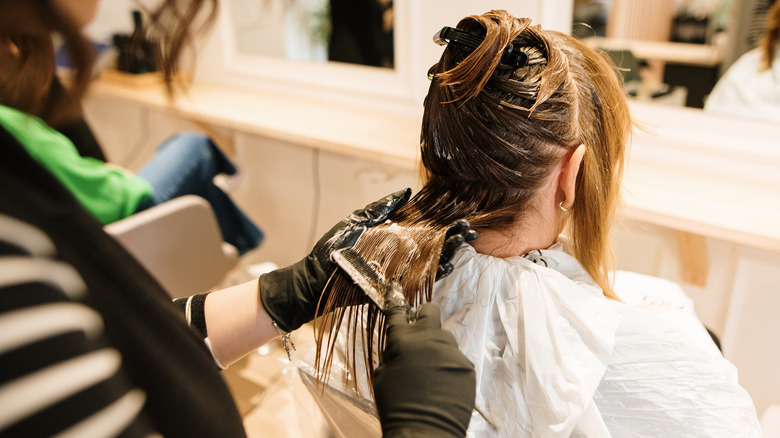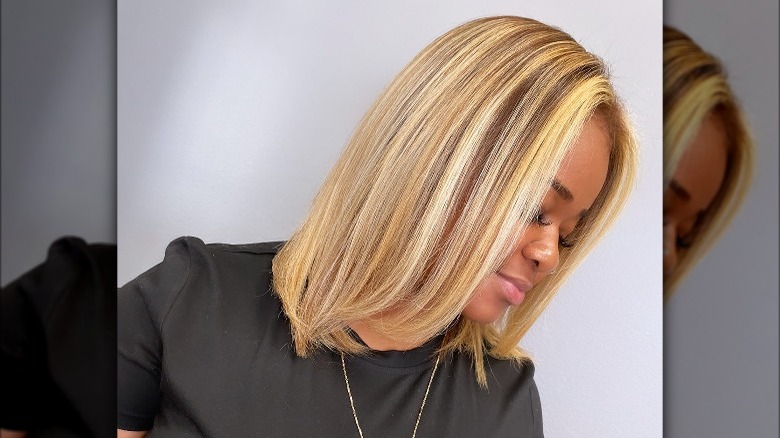Single-Process Color Vs. Double-Process Color: What's The Difference?
Switching up your hair color is a fabulous way to breathe some life into your look without doing too much. Since hair coloring trends are as relevant as ever, a new hair color is a solid "turning my life around" signal. There are so many techniques and application methods out there, from balayage and flamboyage to old-school foiling and highlights.
In order to keep up, it's crucial to know your hair coloring lingo. You may know the difference between highlights and lowlights and what the strawberry blond shade looks like, but the basic hair terms are mostly what you get when your hairstylist is explaining what they're about to do to your hair. In terms of coloring, it's crucial to know the difference between single-process coloring and double-process coloring to know what works best for you.
Single-process coloring is done in one step, while the double-process method consists of two color applications. The two don't mix and are used for different color results. The single-process coloring technique can be combined with other methods, but that usually defeats its purpose. Double-process color, on the other hand, can take your hair color to a completely new shade in a matter of hours. The two coloring methods can also damage your strands on different levels, so make sure to get familiar with them before booking your next hair salon appointment.
Single-process coloring is less damaging
As the name suggests, single-process color — sometimes also referred to as all-over color — is a method of hair coloring that consists of a single application. "Single processes give you an all-over one color with little to no dimension. You may get slight variations of color if you use semi-permanent [hair color]," master colorist Stephanie Brown shared in a conversation with Byrdie, adding that the one-step dyeing technique is "minimally damaging" and great for root touch-ups. Other than all-over hair color, the single-process color method can include highlights that don't need toning as well as hair gloss coloring treatments, as per L'oreal Paris.
The purpose of getting a single-process color, according to colorist Nancy Braun, is "either to lighten the hair, darken the hair ... or change the tone," she explained when talking to Hair.com by L'oreal. The overall process is less time-consuming than your average hair coloring, which consists of multiple steps but may require more upkeep depending on the placement of the hair color.
For example, if you're just doing lowlights that don't require toner, your next maintenance appointment could probably wait for at least a few months. On the other hand, if you went for an all-over color that covers the entire surface of your hair, your roots may start showing fairly quickly. While getting a single shade all-over might make your hair color flat, single-process coloring individual strands can create dimension rather than take it away.
Double-process color can take you from brunette to blond
On the other hand, double-process color requires two coloring treatments to achieve the desired hue. Double-process coloring is what makes it possible to go from brunette to blond in a single session, and the difference between the shades is why the technique takes quite a bit longer than single-process coloring. "First, you lighten it to the desired level, which is usually a pale yellow or pale clear yellow. The second part is putting a toner on it to adjust the tone," Stephanie Brown explained to Hair.com by L'oreal regarding the double process coloring method.
While double-process color is typically done when going from darker to lighter hair, it can also be beneficial vice versa. A second coloring treatment can give your newly dark strands dimension and warmth, as can be seen with Natalia Bryant's cinnamon brown hair color.
Other than the process itself, the main difference between single- and double-process color is the level of damage that you can expect. Double-process coloring includes bleaching the hair to some extent, which is why it will damage your strands more. Braun advises to steer clear of the coloring technique for those who already have thin or fragile hair, or locks that have already been damaged — so maybe don't dye your hair platinum blond if your hair isn't feeling its best.

